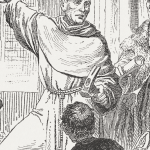Land of the Bible: Benjamin and Jericho
This series delves into the significant sites of Benjamin, including Jericho, and explores the various routes to approach Jerusalem from the east.
Ep. 1 The Pass and Michmash
The eastern flank of Benjamin is anchored by the town of Geba on the south of a wadi that is traversed by a low area called simply “the Pass” (Isaiah 10:28-32). On the north of the Wadi Suweinit is the town of Michmash where was a garrison of the Philistines which Jonathan and his armor bearer attacked after they scaled the northern cliff of the wadi (1 Sam 13:23-14:14).
Ep. 2 Jericho Part 1
What is a “tel”? An artificial hill composed of the layers of a city over hundreds and thoiuands of years. All towns were started near a water source. So is Jericho, which is one of the most powerful springs in Israel.
There are three periods of Jericho 1 excavations: the Germans, John Garstang, and Kathleen Kenyon. Later studies by Bryant Wood confirmed Garstang’s conclusions. The walls were mud brick built on a stone revetment wall. Garstang found the mud bricks fallen down the tel (Joshua 6:10).
The Biblical account stresses the mountain to which the flies fled after helped by Rahab and the inclusion of Rahab in the family of Israel (Josh 6:25; Ruth 4:20-21) and as an ancestor of Jesus (Matt 1:5).
There are three periods of Jericho 1 excavations: the Germans, John Garstang, and Kathleen Kenyon. Later studies by Bryant Wood confirmed Garstang’s conclusions. The walls were mud brick built on a stone revetment wall. Garstang found the mud bricks fallen down the tel (Joshua 6:10).
The Biblical account stresses the mountain to which the flies fled after helped by Rahab and the inclusion of Rahab in the family of Israel (Josh 6:25; Ruth 4:20-21) and as an ancestor of Jesus (Matt 1:5).
Ep. 3 Jericho Part 2
The oldest part of Jericho is a stone tower that may date to 7000 BC. In this video, two of Varner's students assume the roles of two ancient guards sitting on the tower.
The second location is the northern brick wall of Jericho, viewed from the inside and the outside of the wall. Could this be the location of Rahab’s house on the wall (Josh 2:15)? There is then a discussion of faith and evidence in regard to the walls of Jericho. The work of Bryant Wood confirms John Garstang’s conclusion that he found in the destroyed walls of Jericho.
The second location is the northern brick wall of Jericho, viewed from the inside and the outside of the wall. Could this be the location of Rahab’s house on the wall (Josh 2:15)? There is then a discussion of faith and evidence in regard to the walls of Jericho. The work of Bryant Wood confirms John Garstang’s conclusion that he found in the destroyed walls of Jericho.
Ep. 4 Jericho Part 3
From the east side of Jericho we discuss the importance of the powerful spring of Jericho (Ein es Sultan; see I kings 2:19-22). We also look into the curse on its rebuilders (Joshua 6:26), the subsequent rebuilding of Jericho south of the tel (Herod’s Palaces), and the visible remains such as the hippodrome (See Luke 18:35; 19:1ff). From Jericho we can see the site of Mt Nebo across the Jordan and we propose the crossing site just north of Jericho as also the site of Gilgal.
Ep. 5 The Mount of Temptation
After ascending by the cable car, there is a discussion about this mountain being the site of the Temptation of Jesus which is related and compared to the temptation in the Garden of Eden. When viewing the Quarantal Monastery (Latin for 40 days) we discuss the phenomenon of monasticism in the 3rd century and following.
Ep. 6 Mount of Temptation Geography
This video reviews the location of OT Jericho, NT Jericho, and the Hippodrome located now in the midst of the fields of Jericho.
Ep. 7 Wadi Qelt
On the route called Maale Adummim (the Ascent of Blood), we view the Monastery of St George, founded in the fifth century. This yawning ravine begins closer to Jerusalem at En Parat, near to the possible Tomb of Rachel, and deepens the further it descends toward Jericho. On a road like the one we see bandits assaulted a man and the Parable of the Good Samaritan unfolds (Luke 10:25-37).
Another passage that graphically is illustrated here is one favored by both the Essenes at Qumran and by John the Baptist, Isa 40:3-5: A voice of one calling: "In the wilderness prepare the way for the LORD; make straight in the desert a highway for our God. Every valley shall be raised up, every mountain and hill made low; the rough ground shall become level, the rugged places a plain. And the glory of the LORD will be revealed, and all people will see it together. For the mouth of the LORD has spoken."
Another passage that graphically is illustrated here is one favored by both the Essenes at Qumran and by John the Baptist, Isa 40:3-5: A voice of one calling: "In the wilderness prepare the way for the LORD; make straight in the desert a highway for our God. Every valley shall be raised up, every mountain and hill made low; the rough ground shall become level, the rugged places a plain. And the glory of the LORD will be revealed, and all people will see it together. For the mouth of the LORD has spoken."
Ep. 8 High Place of Gibeon Part 1
The site is traditionally the Tomb of Samuel but Samuel was buried in Ramah. From here we can view almost the entire “saddle of Benjamin” to the north; the three towers of Jerusalem to the southeast; and much of the Way of the Patriarchs, the ridge route from north to south on the Central Mountain Ridge of the country. Here can view Mitzpah, Ramah, and Gibeah of Saul, where is the unfinished palace of King Hussein of Jordan.
The location in the video is the High Place of Gibeon where Solomon prayed for wisdom (1 Kings 3).
The location in the video is the High Place of Gibeon where Solomon prayed for wisdom (1 Kings 3).
Ep. 9 High Place of Gibeon Part 2
Edward Robinson identified the tel below us as Gibeon because he heard the Arabic pronunciation of the town as “Jib.” Here Solomon prayed for wisdom. The men from Gibeon tricked Joshua (Joshua 9), however, he honored his treaty with them and relieved the siege on the town (Joshua 10) after an all-night march from Gilgal. He chased them down the Ascent of Beth Horon. “On the day the LORD gave the Amorites over to Israel, Joshua said to the LORD in the presence of Israel: "Sun, stand still over Gibeon, and you, moon, over the Valley of Aijalon" (Jos. 10:12 NIV).
Ep. 10 Gibeah Part 1
The first part of this video provides an opportunity to review that Six Day War in 1967 since the location is the unfinished place of Jordan’s King Hussein. The construction was interrupted by the war.
Gibeah means” hill” in Hebrew and is famous in the OT for being the home of Saul and the site of his palace. Young Saul searched for donkeys here (1 Samuel 10). We discover the sites of Bethel, Michmash, Geba Gibeah, Nob and Jerusalem described in Isa 10:38-42.
Gibeah means” hill” in Hebrew and is famous in the OT for being the home of Saul and the site of his palace. Young Saul searched for donkeys here (1 Samuel 10). We discover the sites of Bethel, Michmash, Geba Gibeah, Nob and Jerusalem described in Isa 10:38-42.
Ep. 11 Gibeah Part 2
In the book of Judges, Gibeah is the town where the rape of a concubine takes place, which leads to a Civil War. The war ends with 400 girls from Jabesh Gilead being brought in to help repopulate the tribe of Benjamin. In the book of Samuel, Gibeah is also mentioned as the place where Samuel passes by King Saul to anoint David as the future king (1 Sam 16). Saul had previously watched the conflict between Jonathan and Michmash in Gibeah (1 Sam 13-14). Later, David lived in Gibeah with his wife Michal and escaped from Saul, who had tried to kill him (1 Sam 19).
The Ridge Route goes northern to south from Shechem, Bethel, Mitzpeh, Ramah, Gibeah, Nob, Jerusalem, Bethlehem, and Hebron.
The Ridge Route goes northern to south from Shechem, Bethel, Mitzpeh, Ramah, Gibeah, Nob, Jerusalem, Bethlehem, and Hebron.
Ep. 12 Rachel's Burial Site
This neglected and overlooked site is called by the Arabs Kiburei Beni Israel. It is located on the border of Benjamin and Judah. It's suggested that this was the burial place of Rachel (Gen 35:16-20) rather than the traditional tomb north of Bethlehem. The evidence is listed in the presentation for this alternative view, including 1 Samuel 10:2 and Jer 31:15, used by Matthew in a messianic sense (2:17).



